Bennemann K.H., Ketterson J.B. Superconductivity: Volume 1: Conventional and Unconventional Superconductors; Volume 2: Novel Superconductors
Подождите немного. Документ загружается.

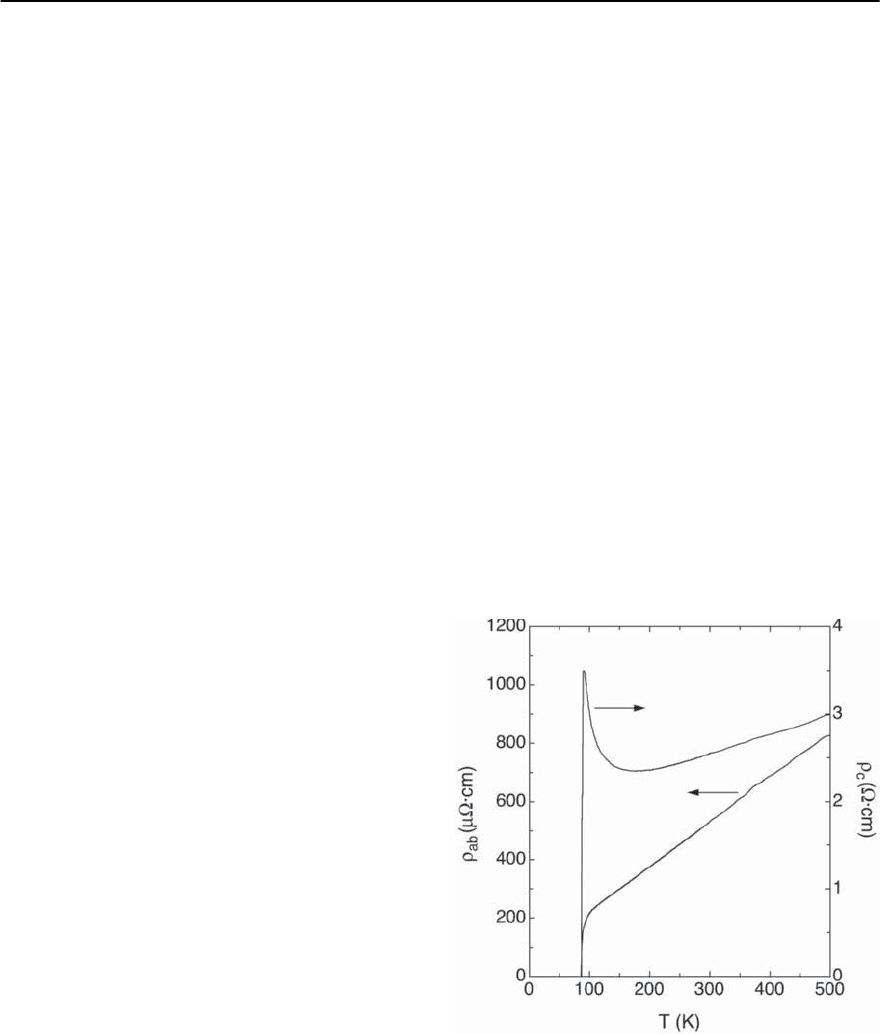
14 High-T
c
Superconductivity 797
i.e., the temperature dependence of F
M
is linear in T
and the slope relates to the critical exponent .Aplot
of F
M
(T), shown in Fig. 14.45, revealsthat a tempera-
ture independent scaling exponent cannot account
for the data and therefore confirms the failure of the
3D XY model in external fields of 1 T and above. In
relation with the superconducting transition in non
zero external magnetic fields it has been realized,also
on the basis of the C(T, H) data presented above,that
the reduced anomalies are due to some crossover
phenomenon rather than a true phase transition.
Guided by theoretical insight [157] a distinct phase
transition of firstorder hasthen be identified by high
resolution measurements of thermodynamical prop-
erties, such as the magnetization [158,159] and the
specific heat [160,161], both as a function of tem-
perature in static magnetic fields. Relevant C(T, H)
data [162] is shown in Fig. 14.46. The first order na-
ture of the transitionis confirmed by the observation
of discontinuities in the magnetization at the same
temperatures where the C(T) anomalies occur, re-
questing the release of some latent heat on general
grounds. The transition is believed to be associated
with the ensemble of the vortices of the mixed state.
Transport Below T
c
(H)
(a) Resistivity
As has already been pointed out above, the zero field
resistive transition is significantly influencedby fluc-
tuation effects,particularly in those cases where the
anisotropy parameter is large. It is also interesting
to note that in the temperature range where the in-
plane resistivity
ab
exhibits the fluctuation induced
paraconductivity, often a substantial increase of the
out of plane resistivity
c
is observed [163],i.e., atT
c
,
∂
c
/∂T is negative. An example of this feature, ob-
served for Bi-2212,is shown in Fig. 14.47. Neverthe-
less,evenin these cases,
c
vanishesin a narrowrange
of temperature,confirming that even for large values
of , superconductivity is still a 3D phenomenon.
Quite unusual, at least in comparison with com-
mon superconductors, is the influence of external
magnetic fields on the resistive transition. First we
consider the influence of external magnetic fields,
oriented along the c-axis, on the in plane charge
transport, i.e.,
ab
(T,H). It may be seen from
Fig. 14.48, where results of measurements [164] of
the in plane resistivity of Bi-2212 are presented, that
an increasing field H does not simply shift the tran-
sition to lower temperatures. Instead, the decrease of
ab
occursin atemperaturerange of increasing width
and from these data it is not a priori clear, where
the resistivity actually vanishes. The extension of the
temperature range of the resistivity drop is partic-
ularly large, if the anisotropy parameter is large, as
in this case. This diagram confirms the above men-
tioned view that a rigorous definition of the upper
critical field H
c2
from resistivity data is difficult. It
turns out that again these features are intimately re-
latedto the behavior of the vortices in themixedstate.
Naturally also
c
(T) is strongly affected by external
magnetic fields. In Fig. 14.49 it may be seen that, be-
cause of the magnetic field shifted transition,
c
of
Bi-2212 continues to increase with decreasing tem-
perature, confirming the characteristically different
chargetransport in the two differentcrystallographic
directions [163]. Also here, the subsequent drop of
the resistivity is rather gradual, indicating a cross
over behaviorrather than a distinctphase transition.
Fig. 14.47. Anisotropy of the temperature dependence of
theelectricalresistivities of single crystallineBi-2212,mea-
sured in theabplane(
ab
)andalongthec-axis (
c
),respec-
tively. Note the different scales for
ab
and
c
(see [163])
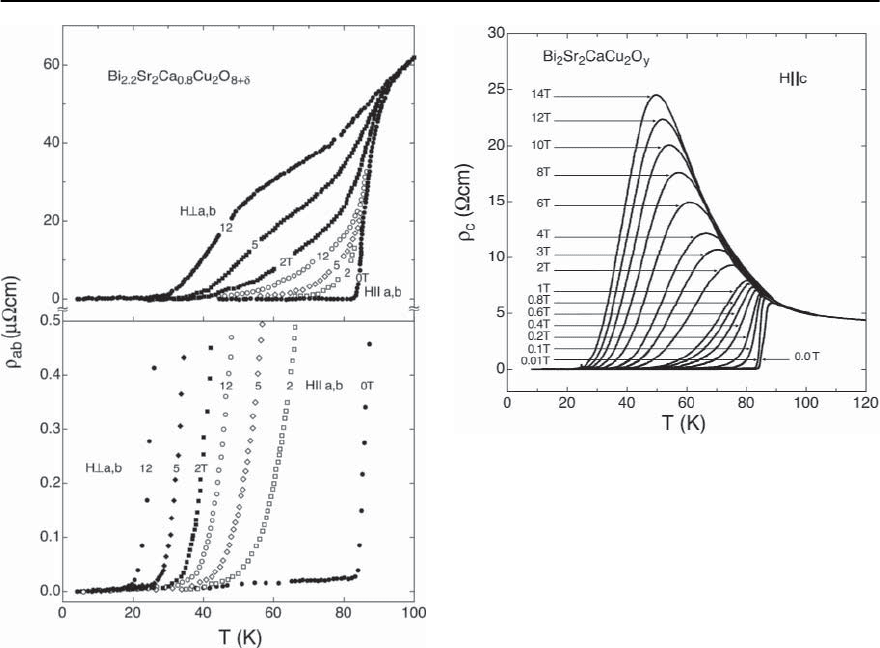
798 H.R.Ott
Fig. 14.48. Magnetic field dependence of the in plane elec-
trical resistivity
ab
(T) at the superconducting phase tran-
sition of single crystalline Bi-2212. Note the difference in
the features, depending on the orientation of the exter-
nal field. The lower frame emphasizes the low resistance
regime (see [164])
(b) Thermal conductivity
Because of the gap formation in the excitation spec-
trum of electronic quasiparticles of superconduc-
tors, the transport of energy or heat is naturally af-
fected by the phase transition.In common supercon-
ductors,because of the gap formation,the electronic
transport of energy, i.e., the corresponding thermal
conductivity
el
, vanishes gradually below T
c
[165].
Because of the reduced rate of scattering of phonons
with electronic quasiparticles, the lattice contribu-
tion to the thermal conduction is expected [165] and
observed [166] to increase with decreasing temper-
ature below T
c
, at least as long as no other scatter-
Fig. 14.49. Magnetic field dependence of the out of plane
electrical resistivity
c
(T) of single crystalline Bi-2212 (see
[163])
ing mechanisms for phonons dictate their mean free
path. The situation seems to be somewhat different
for the cuprate superconductors. In Fig. 14.50 [167]
we show experimental data for the temperature de-
pendence of the thermal conductivity (T) for the
transport of energy parallel to the Cu-O planes of
YBCO-123.Apart from some intrinsic anisotropy be-
tween the a andb direction,themost obvious features
are the discontinuous change of the slope ∂/∂T at T
c
and the distinct maxima of at approximately T
c
/2,
for both crystallographic directions. The anisotropy
ratio of
a
/
b
is constant above T
c
and the en-
hanced thermal conductivity along the b-direction
is attributed to the additional electronic contribu-
tion due to quasiparticle transport along the Cu-O
chains that are,according to Fig.14.6a, extended only
along the b direction of the crystal lattice. The slight
increase of with decreasing temperature in the nor-
mal state is interpreted as being due to itinerant lat-
tice excitations. Although at first sight it is tempting
to ascribe the anomalous increase of below T
c
to
an enhanced phonon conductivity, it turns out [168]
that the observed behavior is rather due to an en-
hanced electronic heat conduction, obviously again
a rather unusual phenomenon but, to a certain ex-
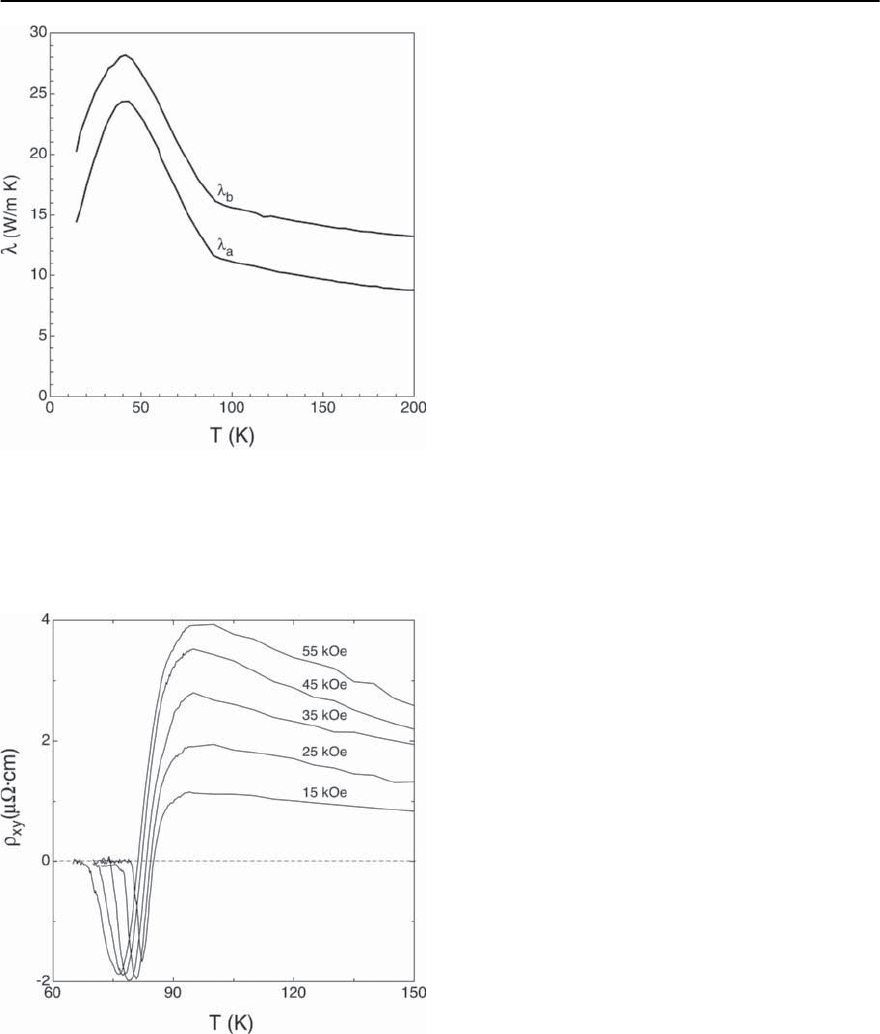
14 High-T
c
Superconductivity 799
Fig. 14.50. Temperature dependences and anisotropy of the
thermal conductivities of single crystalline Y-123, mea-
sured along the a-axis and the b-axis, respectively (see
[167])
Fig. 14.51. Temperature dependence of the in plane Hall re-
sistivity
xy
of single crystalline Y-123 in various external
magnetic fields oriented along the c-axis between 60 K and
150 K
tent, also observed in strongly coupled conventional
superconductors [169,170]. For the cuprates it is as-
cribed [168, 171] to an anomalous decrease of the
quasiparticle scattering rate in the superconducting
state which at first was revealed in experiments prob-
ing the surface impedance of cuprate superconduc-
tors below T
c
[172,173].Assuming that the temper-
ature dependence of the phonon conductivity is not
significantly altered in the superconducting state,the
maxima in are then a consequence of the compen-
sation of the scattering rate reduction by the reduced
number of quasiparticle excitations because of the
gap formation in the superconducting state.
(c) The Hall Effect
It turns out that magnetoresistive effects in these
cuprate materials, at least in experimentally achiev-
able magnetic fields, are not really extraordinary.
This isnot quitetrue for the results of measurements
of the Hall resistivity
xy
. Even for common type II
superconductors,the Hall response in the mixedstate
is somewhat complicated and different model calcu-
lations of what should be expected, lead to different
results[174,175].Thisis even moreso for the cuprate
superconductors where again, some anomalous fea-
tures are particularly well developed. Since the ob-
served anomalous features seem again to be strongly
linked with the properties of the vortex state, we re-
strict ourselves to a brief presentation of the most
important observations. For this purpose we show,
in Fig. 14.51, thetemperature dependence of the Hall
resistivity
xy
(T) of a single crystal of slightly un-
derdoped YBCO-123 in various external magnetic
fields [176]. Most obvious is the sign change of
xy
at field dependent temperatures that are close to but
always less than the zero field critical temperature
T
c
(0) [177].There is a clear negative shift in temper-
ature where the minimum of
xy
is observed, with
increasing external magnetic field. At this point it
should be noted that sign changes of
xy
,although
somewhat less pronounced, have also been observed
in conventional type II superconductors [178]. It is
therefore most likely, that this phenomenon is tied
to the vortex state and its dynamics as such and
not to special intrinsic properties of the cuprate su-
perconductors. Nevertheless, more Although various
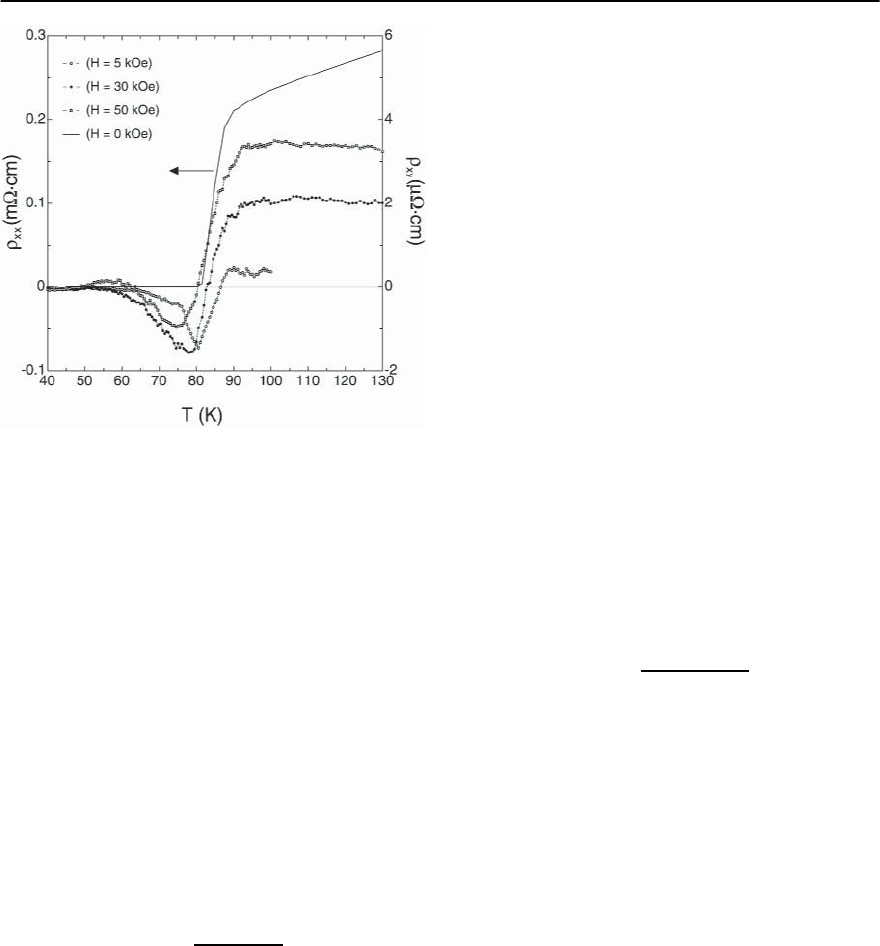
800 H.R.Ott
Fig. 14.52. Temperature dependence of the in plane Hall
resistivity
xy
of single crystalline Bi-2212 in various mag-
netic fields oriented along the c axis between 40 and 130
K. Also shown, as the solid line, is the zero field in plane
electrical resistivity
xx
explanations for these phenomena have been sug-
gested,itismostlikelythattheHallconductivity
detailed investigations indicate that again the degree
of anisotropy and, in addition, the concentration of
holes introduced by doping, play an important role.
Another set of
xy
data,obtained from measurements
on a single crystal of Bi-2212material [179],isshown
in Fig. 14.52. The difference to the results shown in
the previous figure is yet another sign change of
xy
at temperatures much below T
c
[180].Apartfromthis
observation we note that the deviations from the T
−1
behavior of R
H
start at temperatures well above the
zero field T
c
. This seems to indicate that again some
fluctuation effects are significant.
xy
=
xy
(
2
xx
+
2
xy
)
(14.19)
is given by the sum of at least two different contri-
butions [181]. One of them is related to the super-
conducting matrix of the mixed state and the sec-
ond would represent the contribution from excited
quasiparticles in the cores of the vortices. There are
obviously different ways for theoretical treatments
of this problem. A number of publications, consid-
ering either the pinning force, fluctuation effects,
a Magnus-type force, two band effects, or charge
imbalances between the vortex cores and the su-
perconducting matrix are available in the literature
[182–187]. A thorough discussion of all of them is
beyond the scope of this review.
Characteristics of the Superconducting State
(Gap Function)
Thestabilityofthesuperconductingstateis,ingen-
eral terms, guaranteed by the formation of a gap
in the quasiparticle excitation spectrum below T
c
.
At present we do not consider the very special case
of gapless superconductivity [188], sometimes ob-
served in cases where the quasiparticle mean free
path is much shorter than the coherence length. This
condition is notfulfilled in typical cuprate supercon-
ductors. In the most simple approximation, this gap
is assumed to be isotropic in k space and its mag-
nitude at zero temperature, (0), is a measure for
the free energy difference between the normal and
the superconducting state, the condensation energy
E
cond
, via [106]
E
cond
=
D(E
F
) ·
2
(0)
2
. (14.20)
Since this condensation energy is another manifes-
tation of the Meissner–Ochsenfeld effect, its exper-
imental observation, to be discussed in more detail
below,implies theexistence of thisgapalsoincuprate
superconductors. The opening of this gap at T
c
is
also reflected in the almost discontinuous enhance-
ment of the specific heat at the critical temperature
of YBCO-123, measured in zero magnetic field.
All these results from measurements of macro-
scopic properties give only indirect evidence for the
presence of a gap and the real way to go are experi-
ments that probe the excitation spectrum of the elec-
tronic quasiparticles directly. Many early tunneling
data revealed the expected loss of excited states in
a narrow energy range around zero energy [189]. A
new way of exploring the occupation of quasiparticle
states near the Fermi energy of superconductorswas
then offered by a significant progress in improving
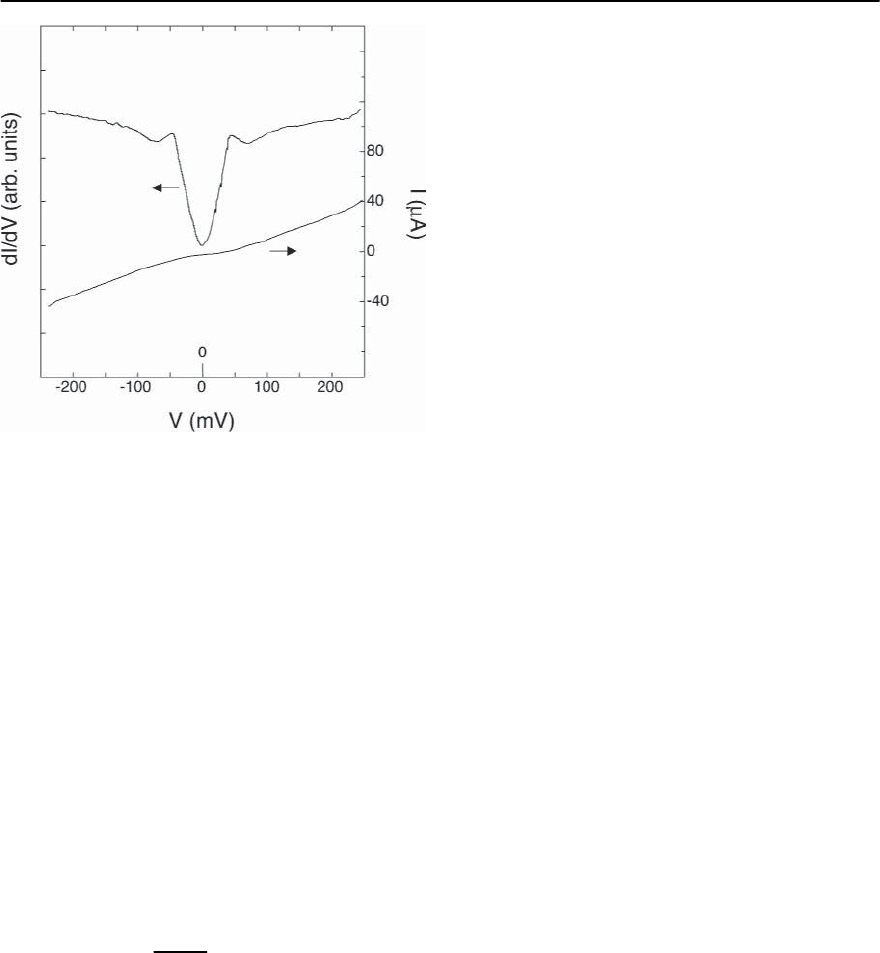
14 High-T
c
Superconductivity 801
Fig. 14.53. Current and conductance vs. voltage character-
istics of a break junction of a Bi-based copper oxide su-
perconductor, reflecting the loss of available states close to
E
F
(see [190])
the energy resolution in measurements of photoe-
mission spectra near E
F
. In Fig. 14.53 we show an
early result of the voltage dependence of the differ-
ential conductivity ∂I/∂V of a break junction of Bi-
based copper oxide, reflecting the loss of achievable
states close to E
F
[190].Beforewe address the issue of
a possible k dependence of the gap function, we con-
sider the informationthat essentially all these exper-
iments provide, the amplitude
0
of the gap function
and its temperature dependence. The zero tempera-
ture value
0
(0) is of interest because, together with
the magnitude of T
c
, it reveals the strength of the in-
teraction that provides the superconducting ground
state. In the weak coupling limit, the relevant ratio,
following from the original BCS theory [106] is
2
0
(0)
k
B
T
c
=3.56 . (14.21)
Larger values, following from direct experimental
evaluations of T
c
and
0
(T) are usually interpreted
as a manifestation of strong coupling effects.Without
going into details, most of the results of experiments
that are briefly discussed below, indicate ratios of
2
0
/k
B
T
c
that are factors of 2 to 3 larger than the
value quoted in Eq. (14.21), at least when probing
the superconducting state in the Cu-O planes, i.e., we
are dealing with superconductivity invoking a very
strong coupling.
Although there was,even before these microscopic
experiments were done, never any serious doubt
that the superconducting gap is well established in
cuprate superconductors,therewas,at first,only lim-
ited interest and correspondingly little information
concerning the k dependence (k)ofthegapinmo-
mentum space. The shape or symmetry of (k )is,to
a certain extent at least, tied to the symmetry of the
pairing configuration and the corresponding order
parameter of the superconducting state. Therefore it
isclear thatexperimentalverificationsof theshapeof
(k) are important and useful for the interpretation
of a variety of experimental data, but especially also
for testing predictions of theoretical models. Con-
sidering the overwhelming evidence that supercon-
ductivity in these copper oxides is mainly due to the
special properties of the Cu-O planes and also taking
into account the atomic arrangement of Cu and O in
these planes, it seems suggestive that the most likely
configuration of the gap function (k)hasad
x
2
−y
2
symmetry, also compatible with predictions assum-
ing nonelectron–phonon pairing mechanisms [191].
In the following, a short presentation of various dif-
ferentexperimentalattempts to evaluate(k) and the
corresponding main results that have been achieved,
is given.
Experiments Probing the Gap Anisotropy
The k-dependence of the gap may have trivial causes.
Its anisotropy may be tied to the anisotropy or shape
of the Fermi surface. It is quite conceivable that an
isotropic gap, which essentially relies on the choice
of a k-independent pairing interaction, is not strictly
realized even in conventional superconductors. This
type of anisotropic gaps, based on a pairing inter-
actionwhosestrengthisnotthesameonallparts
of the Fermi surface, may also be present in con-
ventional superconductors and many indirect evi-
dences for this have been accumulated a long time
ago [192].Of much more interest are cases where the
anisotropy of the Fermi surface and of (k)donot
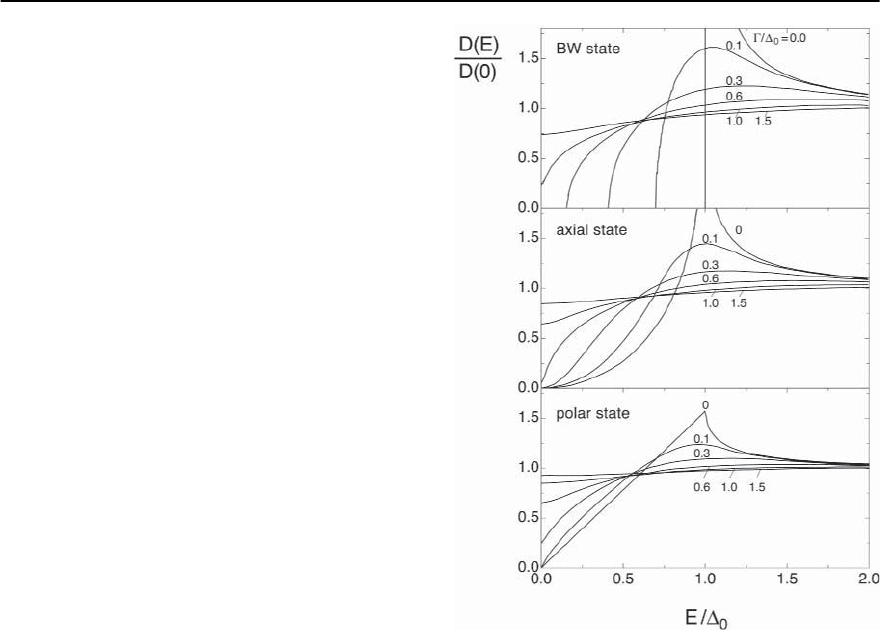
802 H.R.Ott
match. This may best be discussed by invoking the
concept of symmetry breaking at phase transitions,
introduced by Landau [193] and, in more general
terms, by Anderson [194]. For conventional super-
conductors, the formation of a phase-coherent pair
condensate invokes the breaking of the one dimen-
sional global gauge symmetry U(1).A superconduc-
tor is termed unconventional if the corresponding
pair state breaks yet another symmetry, which may,
e.g., be the time reversal symmetry T,thespinro-
tation symmetry R or the translational symmetry X
of the crystal lattice. The resulting symmetry of the
pair state is reflected in the symmetry of the order
parameter and also of the gap function. Even if the
symmetry of the gap function or the order param-
eter is known, it is still difficult or even impossible
to conclude rigourously, which kind of interaction
has produced the observed type of symmetry break-
ing.Aspectsof unconventionalsuperconductivity are
also addressed in the chapter on superconductivity
of heavy electron compounds and have extensively
been discussed in [195].
Additional symmetry breaking and correspond-
ing unconventional pairing configurations often lead
to gap functions (k) with nodes, i.e., zero gap am-
plitudes at points or on lines on the Fermi surface.
Such nodes have a significant influence on the tem-
perature dependence of physical properties that are
dominated by electronic excitations in the super-
conducting state well below T
c
. For superconductors
with conventional pairing, gap nodes may form only
accidentally and usually the gap assumes non zero
values across the entire Fermi surface. In these cases,
all properties of the superconducting state which
are related with the excitation of electronic quasi-
particles, exhibit an exponential temperature depen-
dence at T/T
c
<< 1. This is, of course, not the
case if gap nodes are present. Contrary to conven-
tional superconductors for which at zero tempera-
ture the quasiparticle density of states D(E)iszero
between E = E
F
=0andE = ±,thisisnotso
for many configurations of unconventional pairing.
A well known exception is the superfluid B phase of
liquid
3
He, where an unconventional pair wavefunc-
tion provides a complete non-zero gap [196]. Possi-
ble forms of D(E) close to E = 0 for unconventional
Fig. 14.54. Schematic representation of the energy depen-
dence of the electronic density of states D(E) in the gap
region of unconventional superconductors. The Balian–
Werthamer (BW) state is a nodeless p-wave state. The axial
and the polar state imply point and lines of nodes of the
gap function,respectively.The parameter /
0
is a measure
for impurity induced pair breaking (see [195])
pairing states are shown in Fig. 14.54.As may be seen,
D(E) vanishes in powerlaws of E as E → 0.Thenodes
are not always strictly on points or lines on the Fermi
surface. Impurity scattering may widen these regions
where the gap function vanishes. In some cases this
happens even for tiny amounts of impurities or de-
fects, in other cases, a critical value of impurity con-
centration has to be exceeded in order to achieve a
gapless situation.
As an immediate consequence, the above men-
tioned exponential temperature dependence of phys-
ical properties is replaced by power laws in T. As an
example we may quote the electronic specific heat.
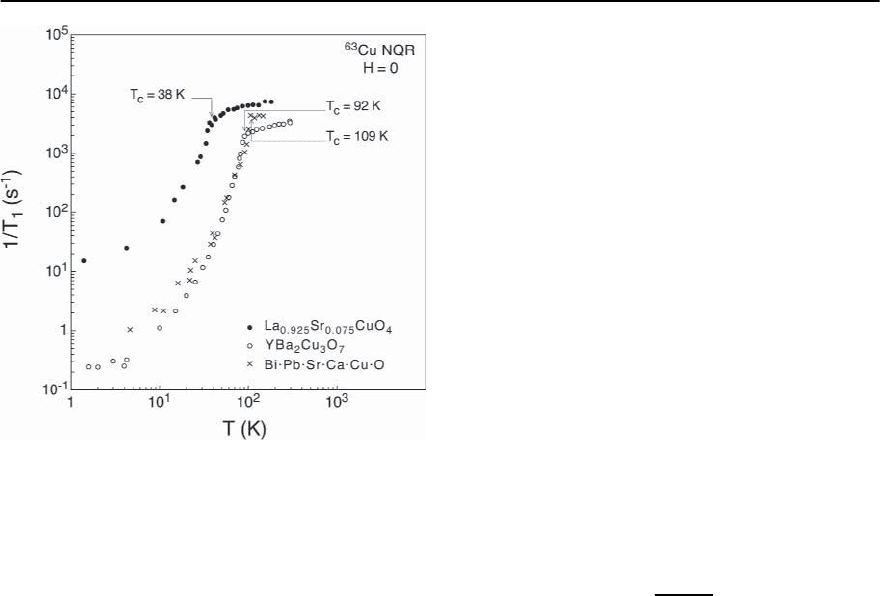
14 High-T
c
Superconductivity 803
Fig. 14.55. Temperature dependence of the
63
Cu NQR spin
lattice relaxation rate T
−1
1
(T) for three different cuprate
superconductors
While for conventional superconductors it is vary-
ing as C(T) ∼exp(-/T), a power law C(T) ∼ T
n
is
expected for unconventional superconductors. The
value of the exponent n depends on the configu-
ration of the gap nodes. It is therefore possible to
identify unconventional superconductors by mea-
surements of the temperature variation of selected
physical properties well below T
c
. Relevant examples
are presented below.
Another feature that is typical for conventional
superconductors but is absent in those of uncon-
ventional varieties, is the observation of coherence
effects that are a consequence of the special configu-
ration of conventional Cooper pairs that are formed
between states with opposite momenta and spins,i.e.,
(k ↑, −k ↓), a major ingredient of the original BCS
theory [106].The observationsof these coherence ef-
fects,which depend on the interactionexerted by the
measuring technique were, at the time, considered
as convincing confirmations for the validity of the
BCS theory [197,198]. Some of the first indications
for unconventional superconductivity in thecuprates
were related with the absence of the coherence ef-
fect that is expected to be observed in measurements
of the temperature dependence of NMR relaxation
rate just below T
c
[197]. An example for this kind
of data is shown in Fig. 14.55 [199]. The drop of the
relaxation rate T
−1
1
, measured for Cu nuclear spins,
is abrupt and quite in contrast to the expected rise
of T
−1
1
with an onset at T
c
, passing over a distinct
maximum somewhat below the critical temperature
and finally decreasing exponentially at T T
c
.This
latter behavior, clearly identified for simple super-
conductors[200],isa typical manifestation of coher-
ence effects.The same set of data,shown inFig.14.55,
has also been claimed to provide evidence foruncon-
ventional superconductivity via the power-law type
temperature dependence of the relaxation rate be-
low T
c
.
(a) Penetration Depth
With respect to cuprate superconductors,anearly in-
dication for unconventional superconductivity was
obtained from measurements of the temperature de-
pendence of the penetration depth
L
(T) for external
magnetic fields well below T
c
[201].In simplest terms
this characteristic length is given by
2
L
=
mc
2
4n
s
e
2
, (14.22)
i.e., it depends on the ratio between the mass m of
the quasiparticles and the density n
s
of quasiparti-
cles condensed into pairs. The latter is temperature
dependent and reaches its maximum value at T =
0K. As mentioned above, the penetration depth may
be measured using the technique of SR. For high
resolution measurements aiming at establishing the
temperature dependence of the penetration depth at
low temperatures, other experiments seem more ap-
propriate, however. Based on microwave absorption
experiments, which are well suited to measure the
temperature induced variation of
L
with respect to
a given value, arbitrarily set to zero, at some chosen
temperature T
0
,quite reliable valuesof
L
=
L
(T)–
L
(T
0
) may be obtained. Corresponding results, ob-
tained for high quality single crystals of YBCO-123at
temperatures above T
0
=1.3 K [201] (see Fig.14.56),
have demonstrated that
L
(
ab
L
in this case) in-
creases linearly with T, at least between 1.3 and 20
K, i.e., well below T
c
of about 90 K. This tempera-
ture dependence of
L
, is a clear indication that the
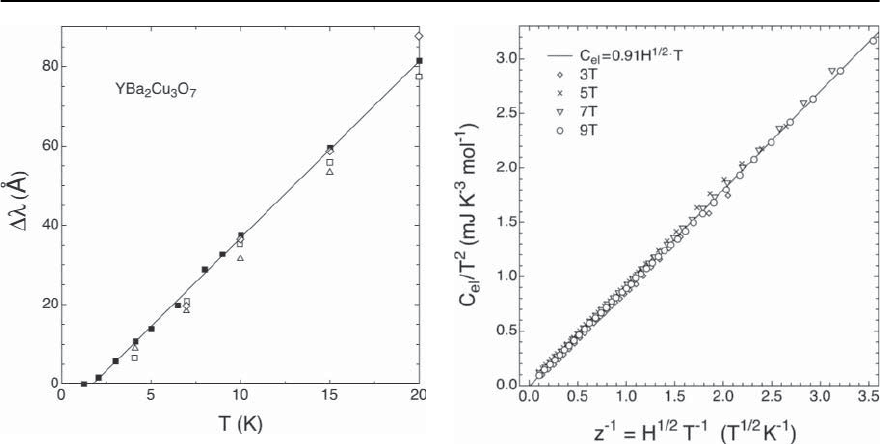
804 H.R.Ott
Fig. 14.56. Temperature dependence of the incremental in-
crease of the in-plane penetration depth of single crys-
talline Y-123. The different symbols represent the data for
different samples (see [201])
gap function of YBCO-123 has nodes, most likely on
lines on the Fermi surface. The claim is quite con-
vincing because a control experiment of the same
type, using a sample of a PbSn alloy, a conventional
type II superconductor, resulted in an exponential
increase of
L
at temperatures well below T
c
=7.2
K of this material. Later experiments [202] revealed
that shortening the quasiparticles’ mean free path by
introducing impurities results in
L
∼ T
2
.
(b) Specific Heat
Since the specific heat C(T) is solely dependent on
the density of states of possible thermally induced
excitations, the temperature dependence of the con-
tribution tothespecific heat due to excited electronic
quasiparticles,C
e
(T),is bound to reflect the presence
of gap nodes. In general, point-type or line-type gap
nodes are expected to result in C
e
(T)beingpropor-
tional to T
3
and T
2
, respectively, at very low temper-
atures at least. Although this verification appears as
being rather trivial in principle, the practical execu-
tion is hampered by the fact, that the subtraction of
not well known background contributionsto C(T)is
less simple as it may seem. Nevertheless, attempts of
this sort have been made, mainly by invoking mea-
Fig. 14.57. Scaling of the low temperature specific heat
of YBa
2
Cu
3
O
7−ı
at different temperatures and in varying
magnetic fields (see [206])
surements of the specific heat of close to optimally
doped YBCO-123, both in zero and non-zero mag-
netic fields H. In some work, a T
2
variation of C
e
at T T
c
and H = 0, indicating line nodes of the
gap [203], was claimed to have been verified [204].
Even more involved is the analysis of specific heat
data obtained in non zero external magnetic fields,
because the structure of the vortices and their nor-
mal cores add to the already present complications.
However, the measured H and T dependencies may
be compared with rigorous theoretical predictions
for the consequences of unconventional gap func-
tions. In particular, line nodes are predicted [205]
to provoke the appearance of a new term represent-
ing the contribution due to the quasiparticle den-
sity of states C
e
, varying as H
1/2
T
−1
and replacing
the T
2
contribution at low temperatures. The pre-
dictions for line nodes include a crossover behavior
at a critical value z
c
= H
c
2
−1/2
T
c
to a high-T,low-
H regime with two separate contributions, an H in-
dependent T
2
term and a temperature independent
contribution varying linearly with H.Bothpredic-
tions have been verified experimentally [204, 206].
One of the verifications of the predicted scaling
of C
e
in the low temperature regime is shown in

14 High-T
c
Superconductivity 805
Fig. 14.57.Another prediction [207,208] for the line
node configuration, the scaling of the anisotropic
component of the field induced specific heat, given
by C
e
(T, H||c)−C
e
(T, H⊥c) has also been inves-
tigated and confirmed experimentally [209]. Analo-
gous experiments with similar results and conclu-
sions, namely the presence of line nodes in the gap
function, have also been made on superconducting
La
1.85
Sr
0.15
CuO
4
[210].
(c) Thermal Conductivity
As we have seen in one of the previous subsections,
the transport of energy or heat in the superconduct-
ing state of cuprate materials is mainly carried by
excited electronic quasiparticles. It may therefore be
expected that at very low temperatures, measure-
ments of the temperature dependence of the thermal
conductivity at temperatures much below T
c
again
provide results that are dictated by the gap config-
uration (k). In particular, again a rather general
theoretical prediction is available for the case of d-
wave typegapfunctionwithlinenodesintwodimen-
sions [211]. It addresses the quasiparticle transport
in such a system and states that this transport should
become independent of the scattering rate as T ap-
proaches 0 K. For a d-wave type gap configuration
it is known that impurities widen the zero gap re-
gions around the line nodes, thereby enhancing the
amount of remnant normal quasiparticles even at
T = 0 K. This enhancement is compensated by the
impurity imposed reduction of the mean free path,
thus resulting in a universal limit of the heat trans-
port. Relevant experimental data for testing this pre-
diction are available for heat transport parallel to the
Cu-O planes of YBCO-123 and Bi-2212 single crys-
tals [212, 213]. In Fig. 14.58 we show the measured
T dependence of the thermal conductivity along the
a axis of YBCO-123 single crystals, doped with dif-
ferent amounts of Zn impurities. It may be seen that
at the lowest temperatures, the ratio /T reaches a
value that is independent of the amount of impuri-
ties and hence the scattering rate. From these results
it is claimed that a universal value of /T does ex-
ist at very low concentrations of impurities [212].In
Fig. 14.59, a comparison of data obtained for the in
planethermalconductivity ofYBCO-123andBi-2212
single crystals confirms that a remnant normal com-
ponent
0
, varying linearly with T,isobservedin
cuprate superconductors at T close to 0 K [213]. For
Fig. 14.58. Variation of the low temperature thermal con-
ductivity along the a-axis of single crystalline Y-123 upon
replacing Cu by Zn (see [212])
Fig. 14.59. Low temperature thermal conductivity of single
crystalline Y-123 and Bi-2212. The solid lines emphasize
the two contributions varying as T and T
3
, respectively
(see [213])
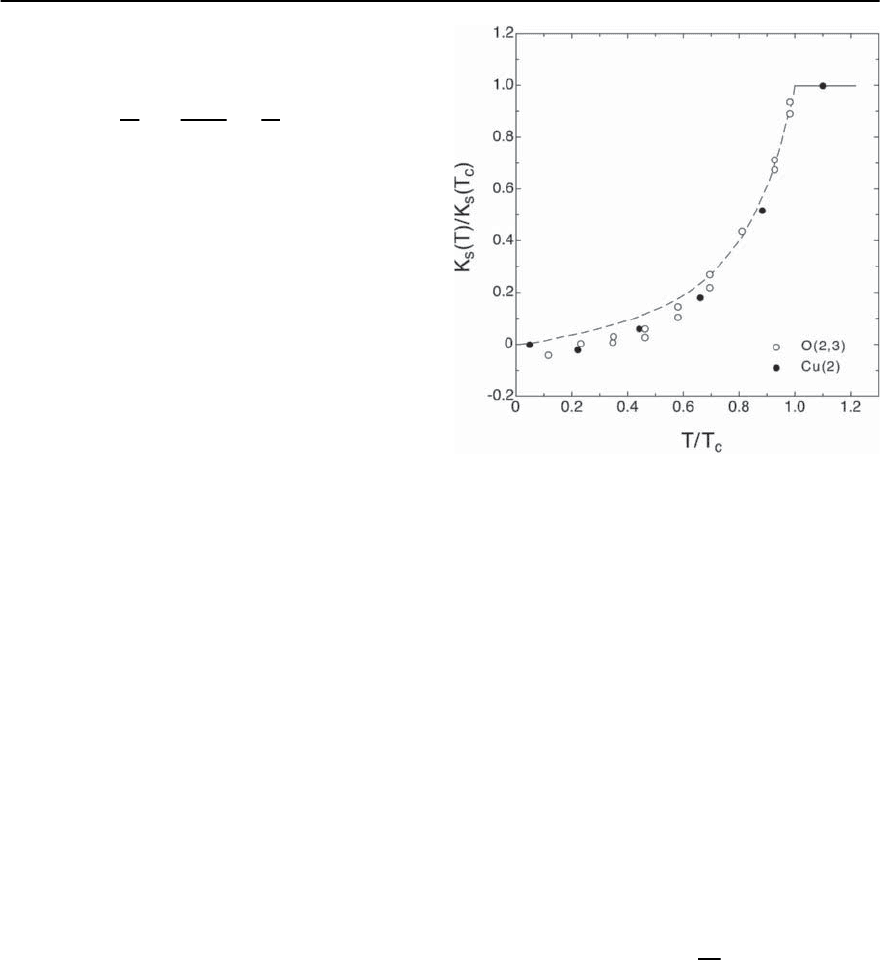
806 H.R.Ott
a d-wave gap configuration, the ratio
0
/T may ap-
proximately be expressed as [214]
0
T
=
k
2
B
· n
3h · d
v
F
v
2
, (14.23)
where n/d is the stacking density of Cu-O planes,
v
F
and v
2
are the Fermi velocity, directed normal
to the constant-energy contour, and the quasiparti-
cle velocity tangential to the Fermi surface at each
node, respectively. It turns out that the ratio v
F
/v
2
can be deduced from direct measurements of the
k-dependence of the gap function (see below) with
ARPES [215]. The values of v
F
/v
2
,calculatedeither
from
0
/T or from the ARPES data differ only in-
significantly, i.e., safely within experimental uncer-
tainties [213].
While these experimental findings strongly sup-
port that the pairing state of cuprate superconduc-
tors implies a gap functionwith linenodesin general
and a d-wave configuration in particular, the good
agreement of the values for v
F
/v
2
from transport
and spectroscopic measurements tends to imply that
the quasiparticles act like those of a Fermi liquid, at
least at low energies. The pros and cons related with
the Fermi liquid description of the normal state have
been addressed in Sect. 14.4.1 above.
(d) Nuclear Magnetic Resonance
The first indications for unconventional supercon-
ductivity from NMR measurements probing the spin
lattice relaxation of Cu and O nuclear spins have
briefly been mentioned in the introductory to sec-
tion of this subchapter. Here we first simply recall
that also the relaxation of nuclear spins via inter-
action with electronic quasiparticles is expected to
reveal the presence of a vanishing gap. This relax-
ation rate provided by this channel is expected to
vanish following a power law in T with decreasing
temperature and not exponentially as in the case of a
nodeless gap. That this is indeed observed is shown
in Fig. 14.55, where it may be seen that the reduction
of T
−1
1
below T
c
is definitely not exponential in 1/T.
Additional relevant information concerning the
gap and even the spin configuration of the pair state
can be obtained from the temperature dependence
of the Knight shift in the superconducting state. As
Fig. 14.60. Temperature dependence of the normalized
Knight shifts of Cu and O NMR signals in the supercon-
ducting state of Y-123. The broken line represents a cal-
culation based on gap function with d-wave symmetry
(see [191])
we have mentioned in Sect. 14.4.1 the Knight shift
K is, via its proportionality to the spin susceptibility
P
of the quasiparticles, proportional to the density
of quasiparticle states at the Fermi energy. For more
complex materials,such as the cuprate superconduc-
tors, other contributionsto the magnetic susceptibil-
ity have to be taken into account.
For conventional superconductors, where K may
simply be assumed to be proportional to the mag-
netic susceptibility and, below T
c
,thetemperature
dependence K(T) is given by the so called Yosida
function [216]. It results from the calculation of the
Pauli-type magnetic susceptibility in the supercon-
ducting state
s
(T) which is given by
s
=−4
2
B
D
BCS
(E)
∂f
∂E
dE , (14.24)
whereD
BCS
= D(E
F
)·|E|/(E
2
−
2
),andf is theFermi–
Dirac distribution function. If the gap function is
nodeless and the pairing is of spin singlet type,
s
vanishes exponentially with decreasing temperature
for T →0 K.For spin triplet pairing the Knight shift
is unaffected by the superconducting transition, i.e.,
